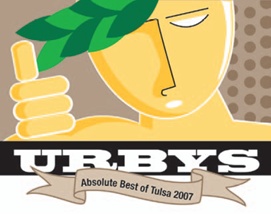Randi's river revisionism
Tulsa County Commissioner Randi Miller held a press conference today to explain why she absolutely has to have a higher sales tax rate in order to build the low-water dams that she promised would be built by the existing Vision 2025 tax.
Miller was responding to a proposal by Tulsa City Councilor John Eagleton, who called for paying for river plan implementation from the existing Vision 2025 sales tax, asking voters to extend that tax if its necessary to complete the projects, rather than increasing the tax rate.
I made a similar proposal in this week's column in Urban Tulsa Weekly. Tulsa County voters were promised three river related projects as part of Proposition 4:
Construct two low water dams on Arkansas River the locations of which will be determined in the Arkansas River Corridor Plan -- $5.6 millionZink Lake Shoreline Beautification -- $1.8 million
Design and construct Zink Lake Upstream Catch Basin and silt removal -- $2.1 million
Last week on KFAQ, Vision 2025 project manager Kirby Crowe said of these funds, only $275,000 has been spent, to cover the cost of environmental paperwork that must be completed prior to constructing the dams. The rest, he said, is "unspent and protected."
In my column, I point out that these dams were promised as a part of Vision 2025, and that County Commissioners committed to completing all the projects as promised, and as quickly as possible. (I do find it interesting that neither of the two Whirled stories, about Eagleton's idea and Miller's response, mentions that construction of the dams were promised as part of Vision 2025.)
Matching funds or not, County officials made a commitment to complete the projects that were promised. In a July 23, 2003, story in the daily paper about the potential for revenues to exceed expected project costs, County Commissioner Bob Dick said that the Vision 2025 package was structured to be sure that no project would be left incomplete. Commissioner Dick was quoted as saying, “I think the worst thing you could do is promise you are going to build something and then not have enough money to build it.” So any surplus was intended first to be used to finish the promised projects.
Miller claims that we can't predict if there would be enough surplus, and if there is any, it's already been promised to the suburbs for unspecified projects.
But I'm told that no such projects have been approved by the Tulsa County Vision Authority and no such commitment was made. Mayor Taylor denies that any such promise was made. Such a promise would directly contradict something Miller was quoted as saying later in the interview:
The commissioners' primary responsibility is to ensure that the Vision 2025 projects promised voters are delivered, she said.
And that means building the low water dams and refurbishing the Zink Lake dams has to come before any new projects are undertaken.
In fact, the ballot resolution makes a formal commitment to that effect:
While the cost estimates shown above are believed to be accurate, it must be recognized that the exact cost of each project may vary from the estimate shown. It is the intention of the Board of County Commissioners of Tulsa County, Oklahoma, that all projects shall be completed as funds are made available. If the Board of County Commissioners of Tulsa County, Oklahoma, determines that all of the projects listed above will be completed with existing and projected funds and that excess funds will be available for additional projects, such excess funds shall be expended for caputal improvements for community enrichment (which does not include appropriation of any such funds to any other entity for such purpose), as determined by a public trust having Tulsa County, Oklahoma, [and all Tulsa County municipalities], as its beneficiaries.
Emphasis added. No new projects until all the listed projects are fully funded to completion.
Miller also claims that we can't get to any of the surplus money until near the end of the tax period, around 2015 or so. But as she knows, Vision 2025 is not a pay as you go project. She and her fellow commissioners have issued revenue bonds, borrowing money against future revenues so that the projects could be completed early, long before we raise the revenue.
I don't know how much has been borrowed all ready, how much has been spent, and how much is committed in the near term, but if the river is a priority, I'm sure some projects can be delayed to so that money already in hand could be used to start work on the dams. I'm sure more could be borrowed against anticipated Vision 2025 revenues. If John Piercey doesn't think he can do it, perhaps we could put the financing out for competitive bidding and find someone who can make it happen without charging us an arm and a leg.
Interesting: According to this, the river projects and all other Vision 2025 projects should have been funded in the second bond issue. The first bond issue was for $242,150,000:
Program manager Kirby Crowe said officials plan to have just one more bond issue to fund the rest of the Vision 2025 projects.The Arkansas River projects, Broken Arrow's funding for downtown and neighborhood beautification, construction costs for the downtown Tulsa arena and renovation of the Maxwell Convention Center -- as well as the rest of the funding for projects that were only partially funded in the first bond issue -- are anticipated to be funded in the second.
Here's Randi Miller from June 2005:
While they aren't ready to act on projections for what the 13-year, sixth-tenths of a penny sales tax will bring in, Commissioners Bob Dick and Randi Miller both believe the Arkansas River is a likely candidate to see additional funding."It's too soon to start spending money above those things that have already been identified," Dick said. "But there's one real easy one, to say if we do have that, I think a high priority would be on the river."
The $5.6 million allocated in Vision 2025 for river projects only pays for a portion of two low-water dams. It is supposed to be used along with federal funds, but Miller said officials may need the extra money to make sure the dams get built.
"If there's any money that's available, in my opinion because we do not have enough for the dams, then I'm going to go with river development," she said.
From the same article, John Piercey provides an early estimate of a surplus and is game to try to make it available early:
Vision 2025 financial adviser John Piercey, a senior investment banker with Capital West Securities, said that virtually all of of the $65 million surplus will be collected in 2016 and 2017."The question becomes: Is there a way to have those funds early? We're working on that," he said.
And as recently as this January, Piercey said:
"It looks like they'll (local officials) be able to deliver everything they promised to voters, and then some."
Make it so.
TAKE ACTION: If you want County Commissioners to keep their promise and fund the low-water dams from the Vision 2025 tax, you need to let them know. The vote to put a new tax on the ballot could come as early as next Thursday. Here are phone and e-mail contacts for each:
District 1, John Smaligo: jsmaligo@tulsacounty.org, 596-5020
District 2, Randi Miller: rmiller@tulsacounty.org, 596-5015
District 3, Fred Perry: fperry@tulsacounty.org, 596-5010
 Alas, I didn't have a sitter, so I had to miss out on Tuesday night's Absolute Best of Tulsa (ABoT) party at the Petroleum Club. I didn't find out until tonight, when I finally had a chance to pick up a copy of the latest issue, but I won an Urby this year. Urban Tulsa Weekly readers have named me Best Blogger in the 2007 Absolute Best of Tulsa awards. Thanks to everyone who voted for me.
Alas, I didn't have a sitter, so I had to miss out on Tuesday night's Absolute Best of Tulsa (ABoT) party at the Petroleum Club. I didn't find out until tonight, when I finally had a chance to pick up a copy of the latest issue, but I won an Urby this year. Urban Tulsa Weekly readers have named me Best Blogger in the 2007 Absolute Best of Tulsa awards. Thanks to everyone who voted for me. 

